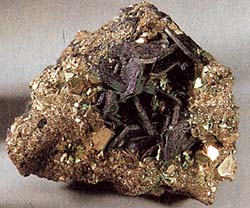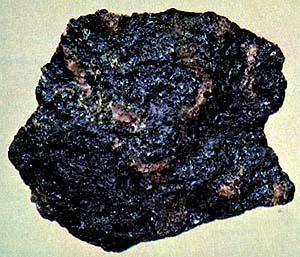Sulphides: Covellite
 Diagnostic card.
Diagnostic card.
Two samples of covellite - a mineral is rarely represented in a distinctly crystalline form.
Cu S (copper sulphide)
Shingoniya hexagonal
Hardness 1.5-2
Specific weight 4.59-4.76
Cleavage is perfect
Rough fracture
Color bluish-black, rainbow
Color in powder gray-blue
Glitter semimetallic

 Cowelline (copper indigo), - copper sulfide. The gloss is metallic or greasy, opaque. The color and the trait are dark blue to blue-black. The fracture is uneven to shell. Cleavage is very perfect. Occurs in the zones of carburizing of copper deposits. Crystals (hexagonal syngony) are very rare, mainly dense masses, granular or powdery aggregates. A useful component of copper ores. Places of manifestation: Germany, Germany, Yugoslavia, USA, Chile, New Zealand.
Cowelline (copper indigo), - copper sulfide. The gloss is metallic or greasy, opaque. The color and the trait are dark blue to blue-black. The fracture is uneven to shell. Cleavage is very perfect. Occurs in the zones of carburizing of copper deposits. Crystals (hexagonal syngony) are very rare, mainly dense masses, granular or powdery aggregates. A useful component of copper ores. Places of manifestation: Germany, Germany, Yugoslavia, USA, Chile, New Zealand.
Crystals are rather rare and always very thin, flattened in the form of a table with hexagonal outlines. Hatching is often observed on the most developed face surfaces. You can meet isolated individuals, as well as fused as rosettes or grouped in the form of subparallel plates.
Chemical composition. Copper (Cu) 66.5%, sulfur (S) 33.5%. Form of crystalline precipitates. Most often, small thin plates, leafy, fine-grained, piecemeal, solid masses. Crystal structure. Hexagonal layered lattice. Class of symmetry. Dihexagonally bipyramidal - 6 / mmm. Cleavage. Perfect in the basis of (0001). Aggregates. Massive, solid, leafy.
Diagnostic signs.
Cowellin is a characteristic and very catchy mineral. It is difficult to confuse with others due to its spectacular bluish-black color and bright semimetallic luster. He is very soft, scratching his fingernail, but quite heavy. In addition, its thinnest plates are flexible, they easily bend, not breaking. Easily melts and lights up with a blue flame, emitting sulfur dioxide.
Origin.
Cowellin is a mineral of essentially secondary origin. It is formed in the oxidation zones of sulfide copper deposits, where it is mainly associated with chalcopyrite, bornite, pyrite and (mainly) enargite. Much rarer it is the result of sublimation (direct deposition upon cooling from the vapor state) in Vesuvius fumaroles. There it is found in the form of crusts of azure blue.

Deposits and applications.
Cowellin is found in various parts of Italy. The rarest finds of crystals up to 1 cm in diameter are made in marbles of Carrara. Several good specimens were found at the Bor deposit in eastern Serbia; Beautiful crystals are found in different places in America (USA), especially in Butte, Montana, and in Kennekot, Alaska. There it is represented in significant quantities and extracted for copper recovery.

Cowellin. Alghero, near Sassari, Sardinia, Italy (EC). Photo: © А.А. Evseev.

Cowelline is crystalline in pyrite. Bor mine, Serbia (EC). Photo: © А.А. Evseev.
- Ghetchellit - "New Almaden blend" - arsenide and antimony sulfide (modern sulfosol)
- Antimony is a toxic metal (semimetal) , widely used in metallurgy, medicine and engineering
- Zirconium - a rare and undiscovered metal and the most dangerous precious stone in oxide and salt
- Gold - yellow dangerous and poisonous metal of modern accurate digital and cable technologies
- Sulfur is a golden-yellow toxic substance and a sign of active volcanic activity
- Cadmium is an undisputed toxic silvery metal unknown to a wide range of people
- Lead - a toxic gray imitator of metallic silver and toxic metal blende
- Arsenic is a classic poison of medieval and modern poisoners and medicine in medicine
Poisonous and radioactive dangerous stones and minerals
** - poisonous stones and minerals (mandatory check in the chemical laboratory + explicit indication of toxicity)
** - radioactive stones and minerals (mandatory check on the standard dosimeter + ban on open sales in case of radioactivity exceeding 24 milli / g / h + additional measures of population protection)
Catalog of minerals and semi-precious stones of the world by groups
** - poisonous stones and minerals
** - radioactive stones and minerals


Comments
When commenting on, remember that the content and tone of your message can hurt the feelings of real people, show respect and tolerance to your interlocutors even if you do not share their opinion, your behavior in the conditions of freedom of expression and anonymity provided by the Internet, changes Not only virtual, but also the real world. All comments are hidden from the index, spam is controlled.